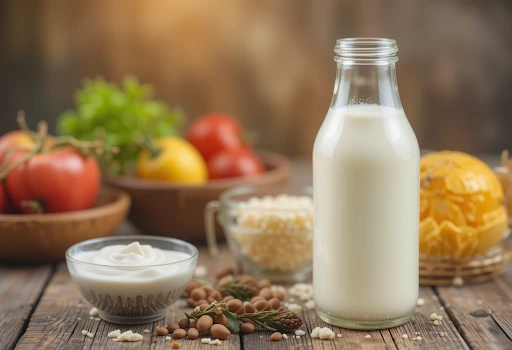How Does Whole Milk Fit Into a Healthy Diet?
How Does Whole Milk Fit Into a Healthy Diet?
Whole milk remains a top dairy choice at grocery stores since it offers both good amounts of protein and vitamin D which benefits bone health. Whole milk enables a simpler way to achieve your daily calcium intake compared to lowfat yogurt and cheese alternatives.
The fat level in whole milk does not seem to result in weight increases. Fats vary which make them function differently in our diets.
From Farm to Table
Whole milk purchases across the United States recently jumped by 13%. I work as a registered dietitian representing dairy farm families from Colorado to southwest Kansas to Montana to Wyoming to New Mexico; as a registered dietitian working on behalf of these dairy farm families I’m often asked how whole milk can fit into a healthy diet; my answer: It certainly can!
Apart from fat content changes all versions of milk contain equivalent protein and vitamin levels and energy value. What sets them apart is their fat content: Whole milk includes 3.25 per cent fat content but other milk types contain less fat.
Before milk arrives at your home fridge it goes through extensive travel starting from production. Dairy farms deliver milk into insulated storage before it travels to processing plants to assess parameters including bacteria levels as well as milkfat percentage and protein content alongside bulk milk cell analyses against additional standards.
After processing milk professionals package it so it goes straight to retailers for customer sales. The common dairy cartons in store reflect dairy farmers’ dedication and precise technology standards and blend two fundamental aspects of the industry – agriculture and innovation – to produce superior milk quality. Milk enjoys continuous global preference because it offers many health benefits which prove its popularity.
Pasteurization
The storage and transportation of milk became a less complicated process because pasteurization first appeared during the 1800s. French scientist Louis Pasteur and chemist Claude Bernard created a method where liquids receive brief exposure to high heat so conditions for harmful pathogens are eliminated while the taste and nutritional quality remains intact. Before pasteurization emerged people died from tuberculosis after consuming raw milk but milk-related death rates fell sharply post its introduction according to Centers for Disease Control reports.
In the United States, High-Temperature Short-Time (HTST) flash pasteurization remains the most widely used method for pasteurizing milk. At VisionNest, we recognize the importance of this process in ensuring food safety while maintaining quality. HTST uses metal plates to rapidly heat milk to 160°F for 15 seconds before immediate refrigeration. While this process may cause minimal nutrient loss, the overall impact is negligible. According to Harold McGee’s On Food and Cooking: The Science and Lore of the Kitchen, plate heat exchangers may introduce slight changes in color or flavor due to mild cooking effects, but these alterations are generally not a cause for concern.
Research confirms pasteurized milk contains reduced vitamin B2 levels yet suggests this nutrient loss isn’t a serious issue given milk isn’t Americans’ primary vitamin B2 food source.
Homogenization
Through homogenization milk remains one single phase because consumers demand a smooth texture for their dairy products. Homogenization works by stopping cream layer formation and allows perfect fat distribution throughout the entire liquid.
Through the use of high-pressure forcing through narrow openings this mechanical operation breaks fat molecules down before spreading them throughout liquids to make stable emulsions which help maintain product shelf life.
Homogenization uses force equivalent to 10 times that of atmospheric pressure, with several factors having an impact: In homogenization/per homogenization three main factors determine emulsion stability during processing which include time under shear force and the number of functional stages. Changes to processing time and the applied shear force affect fat globule size distribution and stability reaching influential levels that will transform your dairy production outcome.
Homogenization changes milk protein structures which leads to varied biological effects that producers must monitor for positive and negative effects. The effect of homogenization demands close monitoring because it presents both useful and problematic possibilities which depend on how it gets used.
Dairy manufacturers need milk homogenization when they want to deliver uniform quality milk products allowing room to add diverse ingredients while extending product shelf life. Through the process of homogenization milk stays creamy until customers buy and drink it.
Packaging
Milk comes in pints, quarts and gallons and its size depends on its level of fat: whole, low-fat and nonfat (or skim). Taking into account the type of fat reintroduced back into milk once separation has occurred all milk needs vitamins A and D before pasteurization for consumption safety.
After pasteurization milk goes into a substantial refrigerated space where it will be stored before store shipping. Liquid product packaging must maintain sanitary conditions and ensures security against tampering which prevents both leakage and spoilage while including oxygen exclusion measures to maintain freshness.
The double coating of food-grade polyethylene on both interior surfaces of cartons prevents leaks while giving their structure more rigidity compared to glass bottles during shipment. Paperboard stands out as a sustainable material which complements the reinforcing capabilities of plastic coatings.
Experiments evaluated milk flavor changes by categorizing skim and whole milk stored in differing materials including paperboard cartons with PET liners as well as high-density polyethylene, PET and LLDPE liners plus glass vessels. The sensory evaluation findings showed that milk still delivered fluid flavor better when stored in cartons versus glass or plastic containers though cartons began developing refrigerator/stale tastes by the tenth day. Analysis showed the method of storage affected study packaging because the materials produced acetophenone and hexanal differently during storage time.
